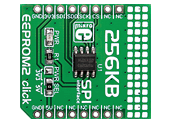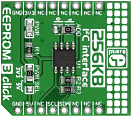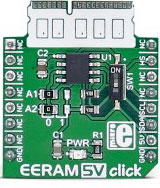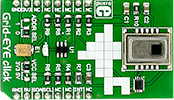Search
Search for "click":
(Click here to search this entire website for "click" with Google.)
 |

|
|
The Dual LIN click is a Click board™ based on the TLE7268SKXUMA1, a Dual LIN transceiver from Infineon. Given the features included in this transceiver, the Dual LIN transceiver designed for data transmission rates up to 20 kbps being fully compliant to the ISO17987-4, LIN specification 2.2A and SAE J2602 standards.
The Dual LIN click is supported by a mikroSDK compliant library, which includes functions that simplify software development. This Click board™ comes as a fully tested product, ready to be used on a system equipped with the mikroBUS™ socket.
|
|
|
|
 |

|
|
EEPROM 2 click carries ST’s M95M02-DR EEPROM chip with 256 KB of memory. The chip has byte and page write speeds equal or less than 10 ms. It's specified for more than 4 million write cycles, with more than 200 years of data retention. The memory, organized as 262144 x 8 bits, has an additional identification page, for storing sensitive application data which can be permanently locked in read-only mode. The board communicates with the target board MCU through the mikroBUS SPI interface (CS, SCK, MISO and MOSI pins). The board is designed to use either a 3.3V or a 5V power supply. |
|
|
|
 |

|
|
EEPROM3 click carries Atmel's AT24CM02 DIP-8 socket EEPROM chip with 256 KB of memory. The chip has byte and page write speeds equal or less than 10 ms. It's specified for a million write cycles, with 100 years of data retention. The memory, organized as 262144 x 8 bits. The board communicates with the target board MCU through the mikroBUS I2C interface (SCL, SDA pins) with speeds up to 1 MHz. An onboard jumper allows you to select the device address (two of them can be connected on the same I2C bus, for a total of 512 KB). The board is designed to use either a 3.3V or a 5V power supply. |
|
|
|
 |

|
|
EEPROM 4 click is 2,097,152 bits on a click board™, organized into 262,144 bytes. In other words, this click board™ is an EEPROM memory medium with the capacity of 256 KB. The used EEPROM module has very good endurance and it can withstand 1,000,000 write cycles, with the data retaining period of about 40 years. The EEPROM module on this click can work with power supply voltage ranging from 1.7V to 5.5V, it features the self-timed write cycles, doesn't require erase before writing, has a dedicated write protect pin for hardware protection of stored data, and has a dedicated hold pin used for holding the data transfer.
EEPROM 4 click is aimed towards industrial and commercial applications, which require low voltage and low power operational capabilities. It can be used for any kind of temporary or permanent data storage for various embedded electronic devices, simple data logging, storing various working parameters of a module or device, safeguarding the sensitive data in case of a power cycle, and other similar applications where EEPROM memory is needed. |
|
|
|
 |

|
|
Add memory to your project with EERAM 5V click. It carries the 47C16 EERAM, a 16Kbit SRAM with EEPROM Backup from Microchip. The click is designed to run on a 5V power supply. It communicates with the target microcontroller over I2C interface, with additional functionality provided by the INT pin on the mikroBUS™ line. |
|
|
|
 |

|
|
EtherCAT Click is a compact add-on board that provides a cost-effective solution for realizing EtherCAT device solutions on various processors over the SPI interface. This board features the LAN9252, a 2-port EtherCAT device controller with dual integrated Ethernet PHYs from Microchip Technology. Each PHY contains a full-duplex 100BASE-TX transceiver and supports 100Mbps operation. The LAN9252 supports HP Auto-MDIX, allowing the use of direct connects or cross-over LAN cables. It communicates with MCU via a synchronous device SPI/SQI interface and can operate in Digital I/O Mode, where signals can be controlled or monitored by the EtherCAT Master. This Click board™ is suitable for industrial control, process/factory automation, hydraulic and pneumatic valve systems, power, and many more.
|
|
|
|
 |

|
|
Expand 8 Click is a compact add-on board that contains a multi-port I/O expander with bi-directional input/outputs. This board features the MAX7317, 10-Port SPI-interfaced I/O expander with overvoltage and hot-insertion protection from Maxim Integrated. The MAX7317 provides microprocessors with 10 I/O ports rated to 7V. Each port can be individually configured as either an open-drain output or an overvoltage-protected Schmitt input that supports hot insertion. All port pins remain high impedance in Power-Down mode with up to 8V asserted on them. This Click board™ is intended for use as a port expander in system monitoring applications, industrial controllers, portable equipment, and many more.
Expand 8 Click is supported by a mikroSDK compliant library, which includes functions that simplify software development. This Click board™ comes as a fully tested product, ready to be used on a system equipped with the mikroBUS™ socket.
|
|
|
|
 |

|
|
GNSS RTK Click is a compact add-on board used to enhance the precision of position data derived from satellite-based positioning systems. This board features the ZED-F9P, a multi-band GNSS module with integrated multi-band Real Time Kinematics (RTK) technology offering centimeter-level accuracy from U-blox. This module concurrently uses GNSS signals from all four GNSS constellations (GPS, GLONASS, Galileo, and BeiDou), and provides multi-band RTK with fast convergence times, reliable performance, and easy integration. It also includes moving base support, allowing both base and rover to move while computing a centimeter-level accurate position between them. This Click board™ is suitable for machine control, ground robotic vehicles, and high precision unmanned aerial vehicles (UAV) applications.
GNSS RTK Click is supported by a mikroSDK compliant library, which includes functions that simplify software development. This Click board™ comes as a fully tested product, ready to be used on a system equipped with the mikroBUS™ socket.
|
|
|
|
 |

|
|
GNSS ZOE Click is a evaluation board for ultra small ZOE-M8Q GNSS SiP receiver from u-blox. Thanks to u-blox's advanced algorithms and complete GNSS solution, the GNSS ZOE click meets even the most stringent requirements in versatile industrial and consumer applications, such as UAVs, vehicles and assets tracking, navigation devices based on GPS and GLONASS, road navigation devices, public transport, wearable devices, and many more. GNSS ZOE is mainly targeted for applications that require a small size device without compromising performance.
GNSS ZOE click is supported by a mikroSDK compliant library, which includes functions that simplify software development. This Click board™ comes as a fully tested product, ready to be used on a system equipped with the mikroBUS™ socket.
|
|
|
|
 |

|
|
Grid-EYE click is a 8x8 thermal array sensor-detector that carries the AMG8853 infrared array sensor from Panasonic. 64 individual thermal sensors build an image on a display. The detecting distance is 5m. |
|
|
|
 |
|
<< First
< Previous
Next >
|
|

